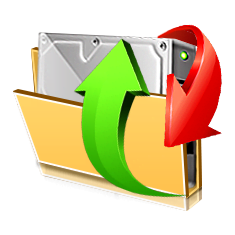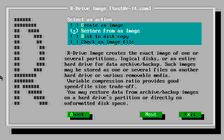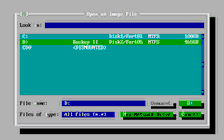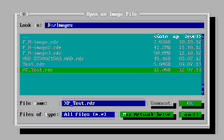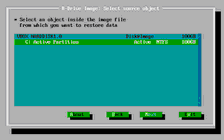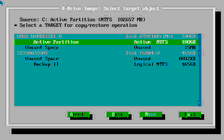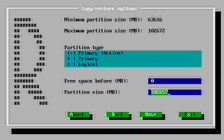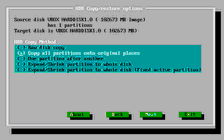


- Contents
- Index
- . -
- A -
- B -
Backup Options
|
|
Ignore disk read errors (bad sectors)
|
|
|
|
|
|
|
|
|
|
Windows Volume Snapshot Service
|
BitLocker
BitLocker System Drive Encryption
- C -
configure startup media troubleshooting options
Contact information and technical support
Context menu
Create a script from an existing task
Create a script from R-Drive Image
Create Partition Parameters
Creating consistent point-in-time bakups
Custom rotation schemes options
Maximum size of all image files
- D -
Dialog boxes
- E -
- F -
File systems
Format partition options
- G -
Grandfather-Father-Son schemes options
Maximum size of all image files
- H -
HDD Copy Method
Copy all partitions onto original places
Expand/Shrink partition to whole disk
- I -
Image file format
Image Options
Volume size for multi-volume image
Image Options options
Compare file contents even for matching files
Remove files in the destination that have no matching files in the source
Shutdown computer when completed
Imaging Options
- K -
- L -
Linux Logical Volume Manager Volumes
List of Hardware Devices Supported in the Startup Mode
Load Computer into Startup Mode
- M -
Mail Notification Options
Media Options
Include R-Drive Image bootable version
Message
Messages
Choose drive(s) to umount them
Error: Another partitioner is active
Image selected is larger than destination
Insert a blank CD-R/RW disk...
Insert the next blank CD-R/RW disk...
Insert the next blank floppy disk...
ISO-image created successfully
|
Startup disks created successfully
Virtual disk(s) mounted successfully
You have selected several partitions...
Mount
Drive letter for the selected partition
Mount an image as a virtual logical disk
- N -
Notifications options
- O -
OEM Client Media Options
Automatically reboot on successful restore
Client will search image on all disks
Perform restoration without confirmation
- P -
Panels
|
Choose destination of new image
Choose image to check integrity
Choose image to mount drive(s) from
Mail Notification/Aux Applications
Removable Media Device Selection
Removable Storage Device Selection
Select disk(s) to create image
Partition layouts
Partition Manager
- R -
RAIDs, and Various Disk and Volume Managers
Restore Options
Drive letter for the selected partition
File system for the selected partitions
- S -
Scheduled actions, command line operations, and scripting
Scheduler and unattended actions
Script commands and parameters
Scripting and command line operations
Simple rotation scheme options
Maximum size of all image files
Create an image using the startup disks
Restore data to a system or another locked disk
Support for Various non-MBR/GPT Partition Layouts
Supported CD and DVD recorders
- T -
Task execution schedule options
Run missed task as soon as possible
Wake the computer to run this task
Tower-of-Hanoi schemes options
- U -
- V -
- W -
Windiows explorer shortcut menu
Windows Software Spanned Volumes
Windows Storage Spaces
Wiping algorithms
Restore Data from an Image
Restoring data to a system or other locked disk:
Note: This help page describes the operation of the TUI startup version. Go to the Restore Data from an Image help page for the GUI version and to the network drives help If necessary.
You cannot restore data to the system (the disk from which Windows starts) or other locked disk the same way you do that to any other disk. You need either to restart R-Drive Image in its startup mode, or start your computer from another computer local disk or from specially created startup disk(s) .
We recommended that you print out this topic and have the hardcopy on hand while you are performing this action.
If there is a non-IDE disk controller in your system, or you plan to use network disks or external hardware devices , first check the List of Hardware Devices Supported in the Startup Mode .
If you plan to use any external device, turn it on before starting the system.
If the image to restore is located on cloud services or other places that may be unavailable to the startup version, copy it to some other location that R-Drive Image can reach.
If the motherboard in your computer supports the Serial ATA (SATA) devices, but IDE disks are also present, only the SATA devices should be set to the Enhanced Mode in BIOS.
Please, note that the startup version of R-Drive Image can restore data only to fixed-provisional Windows Storage Spaces. You may read more about thin-provisioned or fixed Windows Storage Spaces in Microsoft's Storage Spaces Overview .
We recommend you stop all other programs before you start restoring data on a partition.
| 2 | Select Restore Image on the Action Selection panel and press the N key |
Use the arrow keys to switch between the options.
| 3 | Select the file with the image on the Open an Image File panel and press the Enter key |
|
R/O |
Read-only disk. You cannot create images on such disks. |
Use the Tab key to switch between the control areas and the arrow and Enter keys to navigate within the File area.
You may also connect network drives.
| 4 | S elect the object in the image file on the Select an object panel you want to restore data from and press the N key |
Use the arrow keys to select the object.
| 5 | Select time and data of the data to restore on the Select Image Date/Time panel and press the N key |
Use the arrow keys to select the object
| 6 | Select the destination for the data on the Select a target for copy/restore operation panel and press the N key |
Use the arrow keys to switch between the target objects.
|
H |
Hard drive |
|
P |
Primary partition |
|
L |
Logical disk |
|
U |
Unallocated space |
| 7 | Specify restore parameters on the Copy/restore options panel and press the N key |
For restoring/copying one or several partition(s):
|
Restore Options |
|
|
Free space before |
You may specify the size of free space that will be left on the hard drive before the beginning of the partition. |
|
Partition size |
You may specify the size of the partition to be restored. Should be between the minimum and maximum partition size. |
|
Partition type Primary(Active) Primary Logical |
You may specify the type of the partition to be restored. Do not change this setting unless you have serious reasons to do so. |
R-Drive Image startup retains disk letters if it's used on the same computer where it's been created.
For restoring/copying an entire hard drive to another hard drive:
|
HDD Copy Method |
|
|
Raw disk copy |
R-Drive Image writes sector-by-sector the data from the original drive or its image to the target one making an exact copy of the original disk regardless of its partitioning method. Can be used if other methods create a non-bootable disk due to incorrect detection of drive's geometry or non-standard loader. Drawback: partition sizes cannot be changed. |
|
Copy all partitions onto original places |
R-Drive Image copies all partitions to their original places. If R-Drive Image detects the drive's geometry correctly, and there is no non-standard loader, it makes the same result as during Raw disk copy . |
|
Realign partitions |
R-Drive Image will copy the partitions on the disk with a 512KB alignment. This is very useful for SSD and advanced- formatted disks. If there are empty (non-used) spaces between partitions, those spaces will be removed taking into account the alignment. |
|
Expand/Shrink partition to whole disk |
If there are empty (not-used) places between the partitions or they occupy less or more space than the target drive, R-Drive Image proportionally expands/shrinks them to occupy the entire target drive. Otherwise it is similar to Copy all partitions onto original places . |
|
Fixed active partition |
R-Drive Image preserves the original offset/size of the active partition (in case the loader has links to it). |
See Support for Various Disk Partition Schemes and File Systems for details.
When you restore data from an image of a system disk , a disk signature collision may occur. In this case, the Disk Signature Collision panel will appear. You may specify the way to resolve this collision on this panel.
|
Disk Signature Collision Resolving |
|
|
Same signature for both disk |
R-Drive Image will create an identical copy of the source disk with the same signature. To avoid disk signature collision , you'll have to disconnect one of the disks and restart the computer, if necessary. Use this mode if you clone a system disk for another computer or only the target disk will be used in yours. |
|
Different signature on the target disk. |
R-Drive Image will write another disk signature to the target disk. Don’t use this mode if you clone a system disk, Windows won’t start from it. To get access to the target disk after cloning, you’ll have to restart the computer or re-connect it if it’s an external USB disk. |
|
Change the disk signature on the source disk. |
R-Drive Image will change the disk signature on the source disk. Use this mode if you want to start Windows from the target disk, but be warned: the computer won’t start from the source disk anymore. |
| 8 | Verify that the information on the Confirm operations panel is correct and press the N key |
| > | R-Drive Image will start restoring the data from the image file to the selected destination |
The Progress window will show the progress of the current operation and overall process. When the image is restored, the Operation completed successfully message will appear.
| 9 | Verify that the information on the Processing panel is correct and click the Start button |
| > | R-Drive Image will start restoring the files from the image file to the selected destination. |
When the image is restored, the Files restored successfully message will appear.
The Disk Actions chapter explains basic disk actions.
The Startup Version chapter explains how to perform disk actions using the R-Drive Image Startup Version .
The Technical Information chapter gives technical information on Supported CD and DVD Recorders and List of Hardware Devices Supported in the Startup Mode and another useful technical information.
Follow this link to obtain R-Drive Image Contact Information and Technical Support
- R-Studio Technician: activation using a USB stick
- Data Recovery Guide
- Why R-Studio?
- R-Studio for Forensic and Data Recovery Business
- R-STUDIO Review on TopTenReviews
- File Recovery Specifics for SSD devices
- How to recover data from NVMe devices
- Predicting Success of Common Data Recovery Cases
- Recovery of Overwritten Data
- Emergency File Recovery Using R-Studio Emergency
- RAID Recovery Presentation
- R-Studio: Data recovery from a non-functional computer
- File Recovery from a Computer that Won't Boot
- Clone Disks Before File Recovery
- HD Video Recovery from SD cards
- File Recovery from an Unbootable Mac Computer
- The best way to recover files from a Mac system disk
- Data Recovery from an Encrypted Linux Disk after a System Crash
- Data Recovery from Apple Disk Images (.DMG files)
- File Recovery after Re-installing Windows
- R-Studio: Data Recovery over Network
- How To Use R-Studio Corporate Package
- Data Recovery from a Re-Formatted NTFS Disk
- Data Recovery from an ReFS disk
- Data Recovery from a Re-Formatted exFAT/FAT Disk
- Data Recovery from an Erased HFS Disk
- Data Recovery from an Erased APFS Disk
- Data Recovery from a Re-Formatted Ext2/3/4FS Disk
- Data Recovery from an XFS Disk
- Data Recovery from a Simple NAS
- How to connect virtual RAID and LVM/LDM volumes to the operating system
- Specifics of File Recovery After a Quick Format
- Data Recovery After Partition Manager Crash
- File Recovery vs. File Repair
- Data Recovery from Virtual Machines
- How to Connect Disks to a Computer
- Emergency Data Recovery over Network
- Data Recovery over the Internet
- Creating a Custom Known File Type for R-Studio
- Finding RAID parameters
- Recovering Partitions on a Damaged Disk
- NAT and Firewall Traversal for Remote Data Recovery
- Data Recovery from an External Disk with a Damaged File System
- File Recovery Basics
- Default Parameters of Software Stripe Sets (RAID 0) in Mac OS X
- Data Recovery from Virtual Hard Disk (VHD/VHDX) Files
- Data Recovery from Various File Container Formats and Encrypted Disks
- Automatic RAID Parameter Detection
- IntelligentScan Data Recovery Technology
- Multi-pass imaging in R-Studio
- Runtime Imaging in R-Studio
- Linear Imaging vs Runtime Imaging vs Multi-Pass Imaging
- USB Stabilizer Tech for unstable USB devices
- Joint work of R-Studio and PC-3000 UDMA hardware
- Joint work of R-Studio and HDDSuperClone
- R-Studio T80+ - A Professional Data Recovery and Forensic Solution for Small Business and Individuals Just for 1 USD/day
- Backup Articles
- R-Drive Image Standalone and Corporate license transferring
- Fixing Windows update error 0x80070643 with R-Drive Image
- Backup with Confidence
- R-Drive Image as a free powerful partition manager
- Computer Recovery and System Restore
- Disk Cloning and Mass System Deployment
- Accessing Individual Files or Folders on a Backed Up Disk Image
- R-Drive Image startup / bootable version
- File Backup for Personal Computers and Laptops of Home and Self-Employed Users
- Creating a Data Consistent, Space Efficient Data Backup Plan for a Small Business Server
- How to Move the Already Installed Windows from an Old HDD to a New SSD Device and Create a Hybrid Data Storage System
- How to Move an Installed Windows to a Larger Disk
- How to Move a BitLocker-Encrypted System Disk to a New Storage Device
- How to backup and restore disks on Linux and Mac computers using R-Drive Image
- Undelete Articles
- Get Deleted Files Back
- Free Recovery from SD and Memory cards
- R-Undelete: Video Recovery
- Recovery from an External Device with a Damaged File System
- File recovery from a non-functional computer
- Free File Recovery from an Android Phone Memory Card
- Free Photo and Video File Recovery Tutorial
- Easy file recovery in three steps

